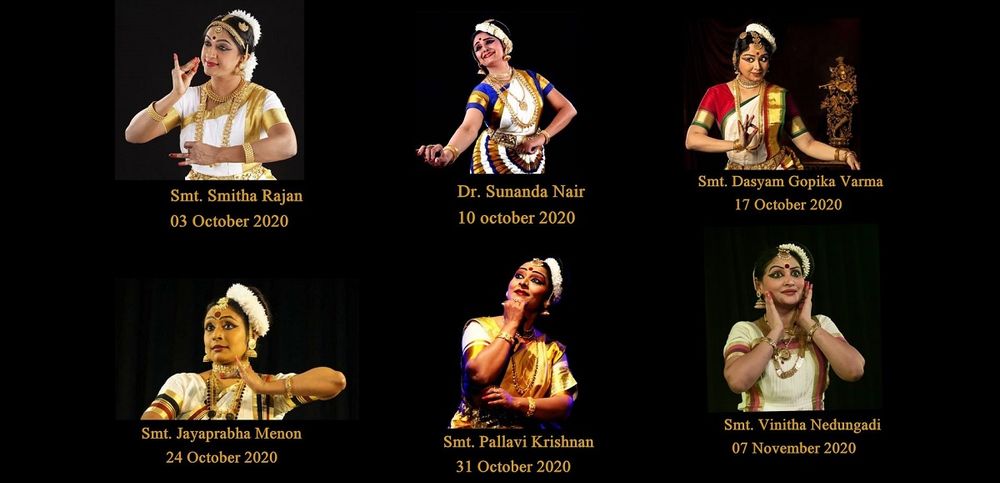Globalisation is helping Mohiniyattam spread worldwide, but that shouldn’t erode the Kerala dance’s spirit, says the Vedhi series online festival organised by Vedhika Performing Arts, New Jersey. The event saw performances by Smitha Rajan, Sunanda Nair, Gopika Varma, Jayaprabha Menon, Pallavi Krishnan and Vinitha Nedungadi.
Mohiniyattam is seeing a surge in authentic practitioners and performance items that has enabled the Kerala dance to come out of its shadow as a poor cousin of Bharatanatyam, according to a pioneering online event, titled ‘Vedhi’ series and organised by Vedhika Performing Arts functioning in New Jersey.
The present era of globalisation has helped Mohiniyattam find exponents in shores far off its home in south India. The trend is welcome so long as the form retains classicism, ‘Vedhi’ series noted.
Speakers at the weekly interactions highlighted the graceful slowness Mohiniyattam movements. This distinction shouldn’t fade in an alacrity to popularise the dance in an increasingly fast-paced world, pointed out six top dancers who addressed the virtual platform organised by Vedhika Performing Arts functioning in New Jersey.
A platform for Mohiniyattam
The transcontinental talks on one’s ‘Journey in Mohiniyattam’ were anchored by Vedhika founder Rubina Sudharman, a young classical dancer who is a disciple of Pallavi Krishnan. The guests at the series that concluded last weekend were Smitha Rajan, Sunanda Nair, Gopika Varma, Jayaprabha Menon, Pallavi Krishnan and Vinitha Nedungadi.
Rubina, who gives both Mohiniyattam and Bharatanatyam recitals, said Vedhi seeks to function as a “learning process for the rest of the generation. It also wants to stay as archives for many to learn.” The online series showcases stalwarts sharing their artistic approach and experiences in popularizing the art. The nascent institution, in Edison township, works “to meet, work and perform with the best choreographers, teachers and legends in the field of dance”. Rubina, a Malayali, has been living in the US for some years now.
Smitha Rajan, who was the guest in the inaugural edition of Vedhi, expressed pleasure over a rise in quality Mohiniyattam artistes in the past two decades. “Globalisation has broken the geographical barriers of this art,” said Smitha, who lives in St Louis of Missouri state and has a grand family lineage in the classical dance of her native Kerala.
Learning and beyond
Smitha’s grandmother Kalamandalam Kalyanikutty Amma (1915-99) had been instrumental in reviving Mohiniyattam in the 1940s. Kalamandalam began a Mohiniyattam wing in 1932. The first batch (1932-1937) had only one student, Thankamani who later married the legendary dancer Guru Gopinath. Kalyanikutty Amma belongs to the second batch (1937-1940).
The dance had a repertoire of just five items, pointed out Smitha. Hailing her grandma’s contributions in enriching the dance and giving it a strong concert format, she gave a list of places Kalyanikutty Amma taught across the country and the way Mohiniyattam’s costume and audio accompaniment evolved over the decades. “Mohiniyattam is my mother tongue,” said Smitha, who runs the Nrithyakshetra dance school at St Louis.
Dr Sunanda Nair, a disciple of veteran Kanak Rele based in Mumbai, has been living in the US for two decades. The globalisation of Mohiniyattam, to Sunanda, began with the study of body movements at the world level.
That learning Mohiniyattam is easy is a deceptive impression one gets on seeing the dance, she said. The maestros do it after so much of practice. Sunanda, who also performs Bharatanatyam and has learned Kathakali, stressed the need to avoid a possible mix-up of the forms on stage. Raised in Mumbai and belonging to a family near Pattambi in central Kerala, Sunanda runs SPARC For Dance & Music she founded in Houston.
Natural is the way
Chennai-based Gopika Varma recalled the snub Mohiniyattam used to face from eminent critics such as late Subbudu. Today, the dance has a variety of styles and a new crop of practitioners. “Mohiniyattam now stands by itself,” said the dancer known for her productions that include one based on the works of Advaita philosopher Adi Shankara. “Every artiste contributes her bit to it.”
Delhiite Jayaprabha Menon, a disciple of octogenarian Kalamandalam Saraswathy, said Mohiniyattam needn’t necessarily go for topical subjects to claim contemporariness. The themes can be of any age; the novelty in their presentation is what updates the art-form, adds Jayaprabha, a native of Kozhikode, who heads the International Academy of Mohiniyattam the Indian capital since 2005.
Pallavi Krishnan is an alumna of Santiniketan in her native Bengal and Kalamandalam in Kerala, where she went on to settle. Unlike in the last century, Mohiniyattam today features in almost all the major dance festivals of the world, added Pallavi, who helms the Lasya Akademi in Thrissur.
Vinitha Nedungadi of Palakkad said globalisation tends to sell consumer products, but they cannot include Indian classical dances however popular they become the world over. People should receive Mohiniyattam in a natural way across continents, she said. Its essence matters much more than the appeal as a visual delight.

